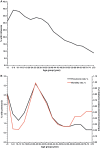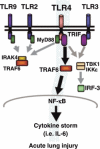Confronting the next influenza pandemic with anti-inflammatory and immunomodulatory agents: why they are needed and how they might work
- PMID: 19627370
- PMCID: PMC4634679
- DOI: 10.1111/j.1750-2659.2009.00090.x
Confronting the next influenza pandemic with anti-inflammatory and immunomodulatory agents: why they are needed and how they might work
Abstract
Despite the best efforts of influenza scientists, companies and health officials to prepare for the next pandemic, most of the world's people will not have access to affordable supplies of vaccines and antiviral agents. They will have to rely on 19th century public health 'technologies' to see them through. In the 21st century, science ought to be able to provide something better. Influenza scientists study the molecular characteristics of influenza viruses and their signaling effects in cell culture and animal models of infection. While these studies have been enormously informative, they have been unable to explain the system-wide effects of influenza on the host, the increased mortality of younger adults in the 1918 influenza pandemic and the much lower mortality rates in children who were more commonly infected with the 1918 virus. Experiments by non-influenza scientists have defined common cell signaling pathways for acute lung injury caused by different agents, including inactivated H5N1 influenza virus. These pathways include several molecular targets that are up-regulated in acute lung injury and down-regulated by anti-inflammatory and immunomodulatory agents, including statins, fibrates, and glitazones. These agents also help reverse the mitochondrial dysfunction that accompanies multi-organ failure, something often seen in fatal Influenza. Observational studies suggest that statins are beneficial in treating patients with pneumonia (there are no such studies for fibrates and glitazones). Other studies suggest that these agents might be able to 'roll back' the self-damaging host response of young adults to the less damaging response of children and thus save lives. Research is urgently needed to determine whether these and other agents that modify the host response might be useful in managing H5N1 influenza and the next pandemic.
Figures


Comment in
-
Invited commentary on David Fedson's article.Influenza Other Respir Viruses. 2009 Sep;3(5):199-201. doi: 10.1111/j.1750-2659.2009.00098.x. Influenza Other Respir Viruses. 2009. PMID: 19702581 Free PMC article. No abstract available.
Similar articles
-
Confronting an influenza pandemic with inexpensive generic agents: can it be done?Lancet Infect Dis. 2008 Sep;8(9):571-6. doi: 10.1016/S1473-3099(08)70070-7. Epub 2008 Apr 15. Lancet Infect Dis. 2008. PMID: 18420459 Free PMC article.
-
Treating influenza with statins and other immunomodulatory agents.Antiviral Res. 2013 Sep;99(3):417-35. doi: 10.1016/j.antiviral.2013.06.018. Epub 2013 Jul 4. Antiviral Res. 2013. PMID: 23831494 Review.
-
The controversy over H5N1 transmissibility research: an opportunity to define a practical response to a global threat.Hum Vaccin Immunother. 2013 May;9(5):977-86. doi: 10.4161/hv.23869. Epub 2013 Feb 7. Hum Vaccin Immunother. 2013. PMID: 23391967 Free PMC article. Review.
-
How will physicians respond to the next influenza pandemic?Clin Infect Dis. 2014 Jan;58(2):233-7. doi: 10.1093/cid/cit695. Epub 2013 Oct 21. Clin Infect Dis. 2014. PMID: 24145877 Free PMC article.
-
Confronting potential influenza A (H5N1) pandemic with better vaccines.Emerg Infect Dis. 2007 Oct;13(10):1512-8. doi: 10.3201/eid1310.061262. Emerg Infect Dis. 2007. PMID: 18258000 Free PMC article.
Cited by
-
Therapeutics against influenza.Curr Top Microbiol Immunol. 2013;370:273-300. doi: 10.1007/82_2011_198. Curr Top Microbiol Immunol. 2013. PMID: 22246228 Free PMC article. Review.
-
Diminished immune responses with aging predispose older adults to common and uncommon influenza complications.Cell Immunol. 2019 Nov;345:103992. doi: 10.1016/j.cellimm.2019.103992. Epub 2019 Oct 10. Cell Immunol. 2019. PMID: 31627841 Free PMC article. Review.
-
Development of effective anti-influenza drugs: congeners and conjugates - a review.J Biomed Sci. 2019 Oct 23;26(1):84. doi: 10.1186/s12929-019-0567-0. J Biomed Sci. 2019. PMID: 31640786 Free PMC article. Review.
-
Neutrophils-related host factors associated with severe disease and fatality in patients with influenza infection.Nat Commun. 2019 Jul 31;10(1):3422. doi: 10.1038/s41467-019-11249-y. Nat Commun. 2019. PMID: 31366921 Free PMC article.
-
COVID-19: The Inflammation Link and the Role of Nutrition in Potential Mitigation.Nutrients. 2020 May 19;12(5):1466. doi: 10.3390/nu12051466. Nutrients. 2020. PMID: 32438620 Free PMC article. Review.
References
-
- Thomas L. Lives of a Cell. Notes of a Biology Watcher. New York: Penguin Books, 1974, pp 78–79.
-
- Gambotto A, Barratt‐Boyes SM, De Jong MD, Neumann G, Kawaoka Y. Human infection with highly pathogenic H5N1 influenza virus. Lancet 2008; 371:1464–1475. - PubMed
-
- Maines TR, Szretter KJ, Perrone L et al. Pathogenesis of emerging avian influenza viruses in mammals and the host innate immune response. Immunol Rev 2008; 225:68–84. - PubMed
Publication types
MeSH terms
Substances
LinkOut - more resources
Full Text Sources
Other Literature Sources
Medical

